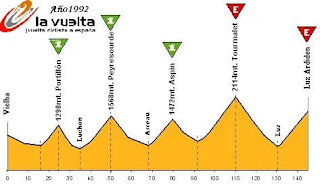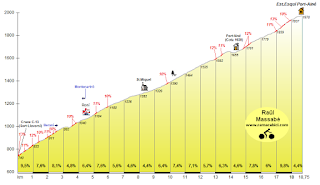 |
Coppi in Cuneo Pinerolo
|
It is difficult to make a list of the hardest stages in Grand Tours ever. After doing some research, you can read this list of 10 stages showing some of the most epic stages in history. Distance and elevation make those stages very special, and some of them will be, no doubt, in cycling History forever.
I've chosen 4 for Tour de France, 4 for Giro d'Italia and 2 from La Vuelta a España.
- Stage
Luchon-Bayonne in Tour de France. Classic stage 326 km long including Peyresourde, Aspin, Tourmalet, Aubisque and the much smaller Osquich. This stage was in the Tour de france route years1910, 1911 and 1912, and opposite direction Bayonne-Luchon (possibly harder as the big climbs are at the end of the stage) was in the years 1913, 1914 and 191 to 1929.
 |
| One of the most famous Tour de France stages, if not the most |
- Tour de France 1983 stage
Bourg d'Oisans-Morzine with 247 km
and 7200 mts elevation including Col du Glandon, La Madeleine, Aravis,
Colombiere, Chatillon and Joux Plane. The winner was Jacques Michaud in
an amazing stage with 7 hours 45' 25". In this stage Laurent Fignon gave a big step to the final overall win.
 |
| Bourg d'Oisans Morzine, epic stage Tour de France 1983 |
- Tour de France 1992, stage
Saint Gervais-Sestriere, 254 km long and 6500 mts elevation, including Col de Saisies, Cormet de Roselend, Iseran, Mont Cenis and Sestriere. Claudio Chiappucci was the winner in an amazing breakaway from km 28, wearing the polka dot jersey. It took 7 hours 44 minutes 51 seconds. Miguel Indurain bonked a few km to the finish line.
 |
| Epic stage ending in Sestriere, Tour de France 1992 |
- Tour de France 1996. Stage
Argeles Gazost-Pamplona, 262 km including Aubisque, Marie Blanque Soudet and Larrau (and still 100 km to go to Pamplona). The winner was the swiss Laurent Dufaux in 7 hours 7 minutes. Indurain said to be the hardest stage in his carrer. No need to say any more.
 |
| The stage should have been a tribute to Indurain. |
- Giro d'Italia 1914. It is said to be the hardest big tour ever with 5 stages over 400 km long. Stage 1
Milano-Cuneo was 420 km long including the climb to Sestriere (this was the hardest stage ever in Giro d'Italia history as per
La Gazzetta dello Sport), but according to other souces, stage 6
Bari-L'Acquila was the hardest, with many riders forced to retire.
- Giro d'Italia 1949. The epic stage
Cuneo-Pinerolo won by Fausto Coppi is one of the most dramatic wins in cycling history, including the climbs to Maddalena, Vars, Izoard, Mongenevre and Sestriere. Coppi won in 9 hours, 19 min 55 sec.
 |
| One of the most famous stages ever. Cuneo-Pinerolo |
- Giro d'Italia 2011
Conegliano-Gardeccia Val di Fassa, 229 km with the climbs to Piancavallo, Forcella Cibiana, Passo Giau, Passo Fedaia and Gardeccia. The winner was the basque Mikel Nieve in 7 hours 27 minutes.
 |
| Conegliano-Gardeccia Val di Fassa, Giro d'Italia 2011 |
- Giro d'Italia 2012:
Caldes-Passo dello Stelvio: 218 km and total elevation 5900 mts, including Passo del Tonale, Aprica, Mortirolo and Stelvio. The winner was Thomas de Gendt in 6hr 54 min 51 sec.
 |
| Queen stage ending at Passo dello Stelvio |
- Vuelta a España 1992
Viella - Luz Ardiden, a stage 144 km long including Portillon, Peyresourde, Aspin, Tourmalet and Luz Ardiden. Total elevation 4500 mts. The winner was Laudelino Cubino in 4 h 52' 36". It is said to be one of the hardes stages in La Vuelta history.
- Vuelta a España 2015,
Andorra la Vella-Cortals d'Encamp 145 km with Collada de Beixalis, Ordino, La Rabassa, Collada de la Gallina, and finish at Cortals d'Encamp at 2005 mts height. About 5000 mts elevation. Stage winner was Mikel Landa in 4hours 34 min 54 sec.
 |
| Stage in Andorra, not a single flat kilometer |
This is my list of hardest stages ever in Grand Tours.
Do you agree? Feel free to share and comment below.


























